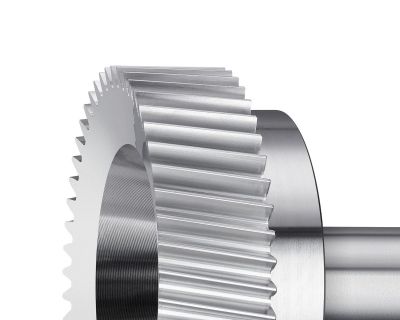Haas to Showcase Gear Skiving Developments at GrindTec 2020
There are an infinite number of different gear geometries. Nevertheless, engineers keep coming up with new variants. Gearboxes are becoming increasingly complex, lighter and smaller. The smooth running must of course be even better than in the series before - and this with the highest demands. The variety of gears knows no limits, but so far, high-precision manufacturing does.
The desired geometry of a gear is often achieved today by so-called skiving. Therefore: the precision of the gear is limited by the precision of the tool. The principle of skiving has been known for over a hundred years, but technology in mechanical engineering has only been able to carry out skiving safely for a few years. That means previously desired precision of the tools and thus the skiving was achieved in complex development steps.
“A few years ago, the quality of gears in classes 4 to 6 was the measure of all things. Today, tolerances of only 2µ are not uncommon," said Wolfram Hermle, software department manager from Haas Schleifmaschinen.
With a high-precision gearbox, the exact timing is everything. The cylindrical wheels must interlock 100%. Flank shape and axis cross angle do not allow deviations, this applies to both internal and external geometries.
The production of such complex profiles requires highly complex calculations. The smallest error continues in the profile accuracy or the division accuracy of the gears and leads to inaccuracies in the entire transmission. Often, the prototype of the transmission does not even show where exactly the error is hidden. It was time for the Haas engineers to act.
"The goal of the mathematicians was to create a calculation basis that is able to handle the incredible variety of variants of all gears. Moreover, this with a precision that opens new horizons for gear manufacturers. Derived from the perfect geometry of a cylindrical gearing, the calculation is based on the geometry of the skiving tool. The motion sequences in production and the relative speed of the flanks define the future geometry of the respective skiving tool," said Hermle.
"We calculate the exact path resulting from the movement of the gear," Hermle does not want to be more precise, because after all, this calculation model is a new development from Haas Schleifmaschinen, which will cause a sensation with its unique position in the market. However, the new calculation model is only one side of the coin.
The other is the implementation. Because precise software requires equally precise coordination with precise hardware. The exact transfer of the Multigrind Horizon software to the machine movement does not allow any deviations. To produce this precision, the alignment of the grinding wheel must be accurate to one ten-thousandth of a degree.
The desired grinding performance cannot be achieved without sophisticated measuring technology and continuous dressing of the grinding wheel. The desired accuracy for the gear skiving tool and then for the gear wheel can only be achieved if all production steps are coordinated with one another in a collaborative process. The results of the permanent re-measurement with subsequent compensation of errors are the basis for the fine correction of the grinding path. This automatic process takes place in the sense of a closed loop. In this way, the quality remains constant and error-free - workpiece by workpiece. The Multigrind Horizon software handles this production sequence reliably and quickly, even in unmanned operation.
"Only when software and hardware are perfectly aligned, than the perfect tool for manufacturing a perfect gear can be created. We at Haas are trained to develop from the desired end product. The question 'What properties should the gear have?' is the starting point of our manufacturing strategy for the perfect gear skiving tool."
Haas will show these new developments at GrindTec 2020 (March 18-21) in Augsburg, Germany.





